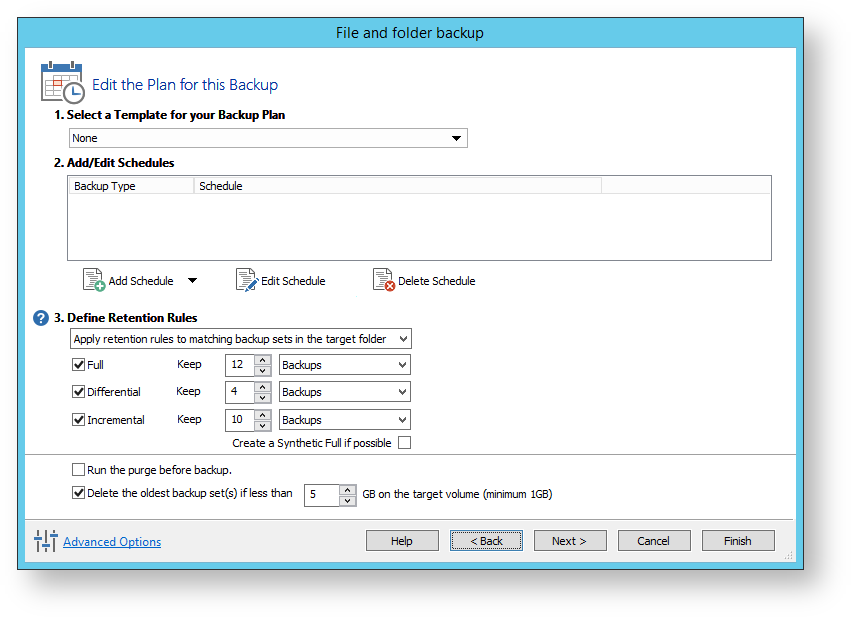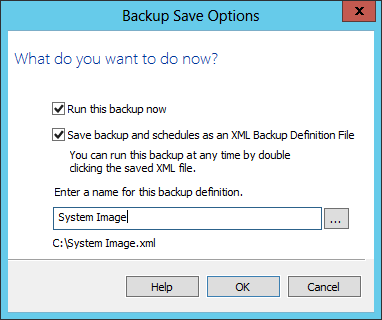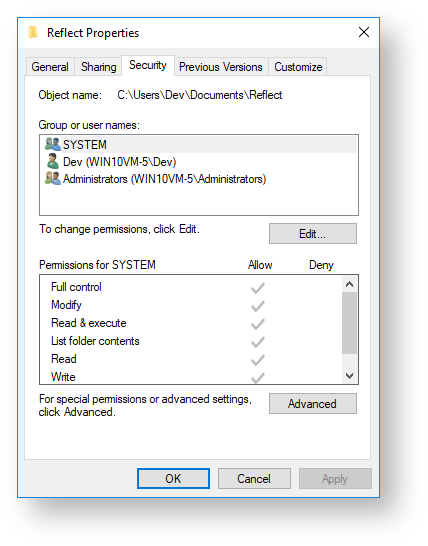A file and folder backup is a useful way to backup your working files, personal files and precious data. Unlike other backup solutions Macrium Reflect can backup open and locked files by using Microsoft Volume Shadow copy Service (VSS). You can backup your Documents folder and save the backup as an XML file for easy re-running and scheduling.
To backup your Windows operating system, do not use a file and folder backup, use an image backup, see Creating a backup of your computer. A file and folder backup is not suitable for restoring your Windows operating system.
From the Backup task bar, select Create a File and Folder backup to start the backup wizard.
Select Add folder.
The Select Folder to backup dialog appears.
Select the folder you want to backup, or the folder containing the files you want to backup. Several different masks and wildcards can be specified to include specific files within the given directory or exclude other files.
Option Description Include subfolders Recurse all folders below the backup folder using the specified filters Exclude hidden files and folders Do not backup files or folders that have the Hidden attribute Exclude system files and folders Do not backup files or folders that have the System attribute Add files to include Add a semi-colon separated list of file name filters to include in the backup. Use the asterisk * character as a wild card.
For example; *.doc; *data*; *.xlsAdd files to exclude Add a semi-colon separated list of file name filters to exclude from the backup. Use the asterisk * character as a wild card.
Note: Exclude filters take precedence over include filtersAdd any folders to exclude Add a semi-colon separated list of folder name filters to exclude from the backup. Use the asterisk * character as a wild card.
Filter names can be full path and/or folder names.
For example:
*temp* will exclude all folders with the letters 'temp' anywhere in the folder name
*\data\temp* will exclude all paths where the folder name begins with 'temp' that has a parent folder named 'data'- Click OK
- Repeat to add further individual directories if necessary.
In the Destination section, specify where you want the backup to be made.
Alternative Locations can be used to provide backup rotations or as a fail safe for temporary unavailability of the primary backup destination.- When you have finished adding folders and making all necessary changes, click Next.
- The Backup Plan Page is shown:
The new Macrium Reflect retention rules provide a powerful and flexible way to manage the lifetime and storage space used by your backups.Choose how backups are matched and retention rules are applied to the target folder
Retention rules are applied to the target folder of the backup by selecting one of two options:
Apply retention rules to matching backup sets in the target folder.
Disk Images are purged if they contain exactly the same Partitions as the current Image. Partitions are identified using the unique Disk ID stored in sector 0 of the disk and the Partition sector offset.Note: For GPT disks the unique GPT disk GUID is used instead of the Disk ID
For File and Folder backups retention rules are applied according to the 'Backup Set Matching' option select in the 'Advanced Properties' for this backup.Apply retention rules to all backup sets in the target folder. All backup sets in the target folder of the same type (Disk Image or File and Folder) are purged according the retention rules.
Note: This option uses the same logic as Macrium Reflect v5
Select the age or number of backup types that you wish to keep
Option Description Full When deleting Full backups all linked incremental and Differential backups in the same backup chain (set) are also deleted This operation will delete the entire backup set. Differential When deleting Differential backups all linked incremental backups in the same backup chain (set) are also deleted. Incremental When deleting Incremental backups the integrity of the backup set is maintained by ensuring that the chain is never broken. This is achieved by merging older Incremental backups when required.
In the example below, before retention, there is 1 Full backup, 1 Differential backup and 6 Incremental backups. The retention rules are set to retain 4 incremental backups. After retention, the most recent 4 incremental backups are retained. Deleting the oldest 2 incrementals would cause the backup chain to be invalid as the oldest retained incremental requires the previous 2 incremental backups to complete the chain. To ensure backup integrity the 2 older incremental backups are consolidated with it to create a new incremental backup.
F= FullD= DifferentialI= IncrementalMTWTFMTWTFMTWFDIIIIFII-- ->ICreate a Synthetic Full if possible When purging Incremental backups, if the backup set only contains a Full backup followed by Incremental backups, then this option causes the Full backup to be 'rolled forward' to create a Synthetic Full backup. This is also known as Incremental Forever.
Run the purge before the backup Select this option to run the retention rules before the current backup.
Note: in Macrium Reflect v5 the current backup set wasn't included in the purge calculation when purging before the current backup. In v6 the current backup set IS included. This means that if you set the retention count to 1 Full backup then all of your backups will be deleted and a new Full backup created.Delete oldest backup set(s) if less than n GB Automatically remove the oldest backup set(s) in the target folder if the free space on the drive drops below the GB threshold.
Note: The free space threshold is actioned dynamically. If the free space available drops below the threshold then the running backup is temporarily paused while older backup sets are purged.
- The summary screen gives the details of what is being backed up. Click Finish.
You are now given the opportunity to save the backup options.
The backup Save Options Dialog enables you to save your backup options as a re-usable XML definition file.This is essential for many operations in Reflect including Scheduling and creating Incremental and Differential backupsOption Description Run this backup now Create a 'Full' backup now using the backup definition Save to an XML file Saving your definition enables you to:
- Re-run the same backup without stepping through the wizard
- Run Incremental and Differential backups
- Schedule your backups
- Create a Desktop shortcut for running with one click
Name for this backup definition Enter a meaningful name for this definition Choose a folder to save the XML definition to.
Always save to a local folder. It isn't necessary to save the definition to the same folder as your backup targetNote: Always save your definition to a local drive and never to a password protected network share.See also: Manually running a job from a configured XML backup definition
Best practises for saving Macrium Reflect backup definition files
Regardless of your PC environment, leaving your backup definition files in an insecure location is bad practice. The effort required to ensure your files are secure is minimal and doesn't impede day to day usage of Macrium Reflect.
What's the problem?
Backup definition (.xml) files are used to initiate backups either interactively by using Macrium Reflect directly, or as scheduled tasks using the Windows Tasks Scheduler. If you save your backup definitions to a publicly accessible folder then these can be edited by standard users and could potentially compromise your system. In addition, it's also possible to create batch files, either MS-DOS, PowerShell or VBScript, to automatically run during your backups as described here. A restricted user with bad intentions could easily create a batch file to run with elevated privileges when a scheduled or interactive backup runs.
The default, and recommended, location for your backup definitions is folder 'C:\users\<USER NAME>\documents\reflect'. When running Reflect for the first time this location is created and defaulted when saving. See Backup Save Options for more information on how to save your definitions.
This folder is automatically restricted for standard users and can only be accessed by Administrators and the local SYSTEM account.
To see assigned NTFS permissions right click on any folder, select 'Properties' and click the 'Security' tab:
In the above example only SYSTEM, Dev (the Macrium Reflect user) and the Administrators group can access files contained in the folder. Standard users are denied access and cannot modify or create files.
We strongly recommend that, if not using the default location. you ensure that NTFS permissions are used to prevent unauthorised modification and creation of files in your backup definition folders.
For more information on setting NTFS permissions for folders and files please see Microsoft TechNet - How IT works NTFS Permissions
Note: A popular misconception is that backup definition files should be saved to the same folder as your backup files. This is incorrect. Backup definitions are only required to create backups and have no other purpose. They are not required for restore.
If you want to run the backup at this point, select 'Run this backup now' and click OK.









